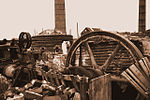Woodville railway station (England)
1851 establishments in England1947 disestablishments in EnglandDisused railway stations in DerbyshireFormer Midland Railway stationsPages with no open date in Infobox station ... and 3 more
Railway stations in Great Britain closed in 1947Railway stations in Great Britain opened in 1883Use British English from November 2018

Woodville railway station is a former railway station on the Swadlincote Loop Line which served the village of Woodville, Derbyshire, England.
Excerpt from the Wikipedia article Woodville railway station (England) (License: CC BY-SA 3.0, Authors, Images).Woodville railway station (England)
Station Road, South Derbyshire
Geographical coordinates (GPS) Address Nearby Places Show on map
Geographical coordinates (GPS)
| Latitude | Longitude |
|---|---|
| N 52.7683 ° | E -1.5272 ° |
Address
Woodville
Station Road
DE11 7DX South Derbyshire
England, United Kingdom
Open on Google Maps









